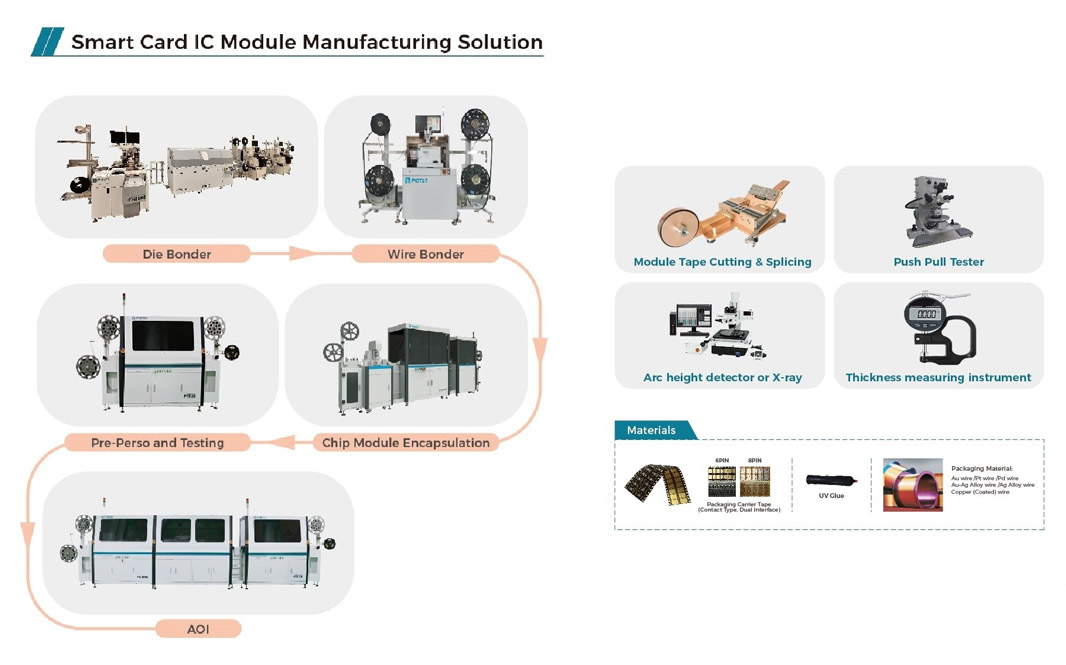Smart card IC module Assembly and test line refers to a series of equipments and processes used to produce and test the IC module in the smart card (such as bank card, SIM card, etc.) . Smart Card IC module is the core of smart card, responsible for data storage and processing. Encapsulation and testing are two key steps in the production process of IC module of smart card. They ensure the function and reliability of IC module.
Encapsulation is the installation of a bare IC chip into a protective housing to facilitate use in smart card and protect the chip from physical damage. The packaging process usually includes Die bonding, Wire bonding, adhesive coating, pre-personalization, testing and so on.
Die bonding, refers to the bare chip (Die) fixed to a substrate or carrier, the substrate can be printed circuit board (PCB) , ceramic or plastic packaging, etc. . Die bonding requires not only the physical fixation of the chip, but also good electrical connections and thermal management. Die bonding is a complex process in semiconductor manufacturing that requires sophisticated equipment and a high degree of technical expertise. The main technologies include:
Welding bonding: the use of metal solder (such as gold, tin or silver, etc.) at high temperature chip and substrate welding together. Soldering provides good electrical and thermal bonding, but the high temperatures in the process can cause damage to the chip.
Silver bonding: using silver-containing conductive adhesive bonding chip and substrate. Silver bonding is a low-temperature process suitable for temperature-sensitive applications. It provides good electrical connection, but thermal bonding performance may not be as good as soldering bonding.
Epoxy bonding: chips are bonded to a substrate using epoxy as an adhesive. Epoxy bonding is a low-cost method suitable for applications that do not require high electrical or thermal performance.
Pressure bonding: pressing a chip into an adhesive on a substrate by physical pressure. This approach is simple and fast, but may not provide sufficient long-term reliability.
Ultrasonic bonding: the chip is bonded to a substrate using heat and pressure generated by ultrasonic vibration. This method is mainly used for gold wire bonding, but can also be used for some types of chip bonding.
Wire bonding uses gold or aluminum wires to connect tiny contact points on the chip to pins on the carrier for electrical bonding. Is a chip manufacturing technology widely used in the semiconductor package process, tiny contacts on a chip used to connect an integrated circuit (IC) or other semiconductor device to a lead frame or printed circuit board (PCB) inside its package. This process is critical to ensuring the functionality of electronic devices because it provides the path of electronic signals and power between the chip and the outside world.
Ball Bonding: this is the most common type of wire Bonding, mainly using gold (AU) or aluminum (Al) wire. The ball bonding process begins by using a flame or arc to melt one end of the gold wire to form a ball. The ball is pressed against the chip's pad to form the first contact, and the gold wire moves through the bonding head to the second contact position (usually the lead frame or the pad on the PCB) , there cut the gold wire and form a second contact. This method is commonly used for gold wire bonding.
Wedge Bonding: Wedge Bonding can be performed using gold or aluminum wires. Unlike ball bonding, wedge bonding uses the same bonding technique between two contacts. The bonding head presses the wire on the first contact to form bonding, then moves to the second contact, presses down again to form the second bonding, and finally cuts the wire. Wedge bonding is suitable for lower temperatures and smaller pad sizes.
adhesive coating: it is mainly used to protect the electronic component from the outside environment, such as humidity, dust, chemical corrosion, etc. . It also provides a certain degree of physical protection against mechanical damage. This packaging technology is widely used in various electronic devices and circuit boards, especially in the need to enhance environmental adaptability and reliability of the occasion.
Pre-personalization: pre-configuring some of the basic information or functions of the chip according to specific application needs or customer preferences. This data may include unique identifier (such as serial numbers) , encryption keys, user information, etc. . Writing this data to the chip usually requires specific hardware and software support.
Testing: after the pre-personalization operation, test and verify to ensure that the chip's pre-personalization configuration is correct and that each module works as expected. Testing usually involves:
Electrical Testing: check the IC module's electrical characteristics, such as power consumption, operating frequency, etc. , to ensure that it meets the specifications.
Function test: verify the function of IC module by simulating the actual application scenario.
Performance Testing: evaluate the performance of IC modules under different conditions, including the impact of environmental factors such as temperature and humidity.
Life test: simulate the conditions of long-term use, test the reliability and durability of the IC module.

Smart card IC module Assembly and test line is highly integrated with automatic equipment, which can ensure the production efficiency and product quality. Precision equipment and strict quality control are required at every step from chip packaging to final testing. With the continuous expansion of smart card applications, the demand for IC modules is also growing, promoting the continuous progress and innovation of testing technology.
As an enterprise engaged in the research and development of smart card and chip equipment for many years, PIOTEC, the smart card manufacturers, has rich technical accumulation in the field of IC module sealing and testing of smart card, according to customer needs (different technical routes, production capacity, cost input, etc.) to provide the actual integration of smart card IC module sealed test production line. It includes Die bonding equipment, Wire bonding equipment, module strip sealant equipment, module strip initialization data writing and testing equipment, AOI testing equipment and so on.

Contact Piotec for Smart Card Solution


